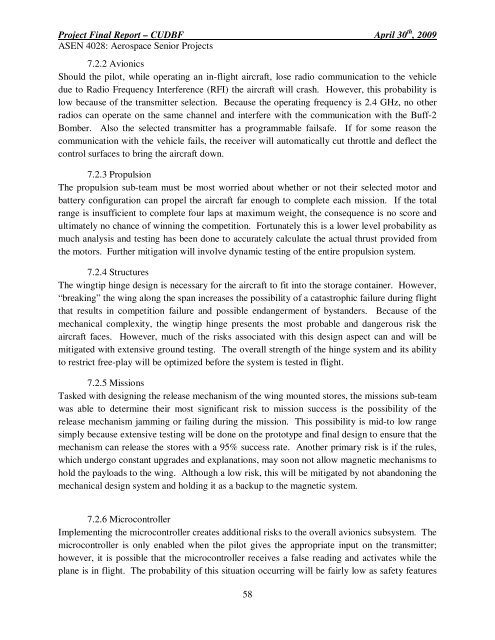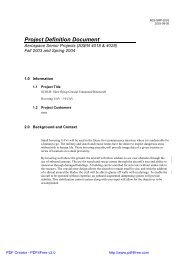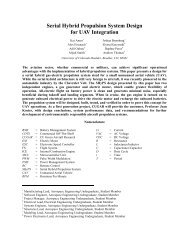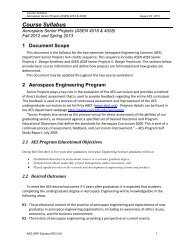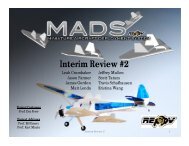PFR - Aerospace Engineering Sciences Senior Design Projects ...
PFR - Aerospace Engineering Sciences Senior Design Projects ...
PFR - Aerospace Engineering Sciences Senior Design Projects ...
Create successful ePaper yourself
Turn your PDF publications into a flip-book with our unique Google optimized e-Paper software.
Project Final Report – CUDBF April 30 th , 2009<br />
ASEN 4028: <strong>Aerospace</strong> <strong>Senior</strong> <strong>Projects</strong><br />
7.2.2 Avionics<br />
Should the pilot, while operating an in-flight aircraft, lose radio communication to the vehicle<br />
due to Radio Frequency Interference (RFI) the aircraft will crash. However, this probability is<br />
low because of the transmitter selection. Because the operating frequency is 2.4 GHz, no other<br />
radios can operate on the same channel and interfere with the communication with the Buff-2<br />
Bomber. Also the selected transmitter has a programmable failsafe. If for some reason the<br />
communication with the vehicle fails, the receiver will automatically cut throttle and deflect the<br />
control surfaces to bring the aircraft down.<br />
7.2.3 Propulsion<br />
The propulsion sub-team must be most worried about whether or not their selected motor and<br />
battery configuration can propel the aircraft far enough to complete each mission. If the total<br />
range is insufficient to complete four laps at maximum weight, the consequence is no score and<br />
ultimately no chance of winning the competition. Fortunately this is a lower level probability as<br />
much analysis and testing has been done to accurately calculate the actual thrust provided from<br />
the motors. Further mitigation will involve dynamic testing of the entire propulsion system.<br />
7.2.4 Structures<br />
The wingtip hinge design is necessary for the aircraft to fit into the storage container. However,<br />
“breaking” the wing along the span increases the possibility of a catastrophic failure during flight<br />
that results in competition failure and possible endangerment of bystanders. Because of the<br />
mechanical complexity, the wingtip hinge presents the most probable and dangerous risk the<br />
aircraft faces. However, much of the risks associated with this design aspect can and will be<br />
mitigated with extensive ground testing. The overall strength of the hinge system and its ability<br />
to restrict free-play will be optimized before the system is tested in flight.<br />
7.2.5 Missions<br />
Tasked with designing the release mechanism of the wing mounted stores, the missions sub-team<br />
was able to determine their most significant risk to mission success is the possibility of the<br />
release mechanism jamming or failing during the mission. This possibility is mid-to low range<br />
simply because extensive testing will be done on the prototype and final design to ensure that the<br />
mechanism can release the stores with a 95% success rate. Another primary risk is if the rules,<br />
which undergo constant upgrades and explanations, may soon not allow magnetic mechanisms to<br />
hold the payloads to the wing. Although a low risk, this will be mitigated by not abandoning the<br />
mechanical design system and holding it as a backup to the magnetic system.<br />
7.2.6 Microcontroller<br />
Implementing the microcontroller creates additional risks to the overall avionics subsystem. The<br />
microcontroller is only enabled when the pilot gives the appropriate input on the transmitter;<br />
however, it is possible that the microcontroller receives a false reading and activates while the<br />
plane is in flight. The probability of this situation occurring will be fairly low as safety features<br />
58


